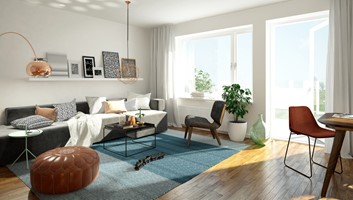 Decorating a home is no simple task. You have to consider the architectural style of the house, how to best use the space to avoid clutter, and to give the home a sense of cohesion and continuity across the rooms.
Decorating a home is no simple task. You have to consider the architectural style of the house, how to best use the space to avoid clutter, and to give the home a sense of cohesion and continuity across the rooms.
Professional interior decorators attend school and earn degrees and certificates that help them make these difficult decisions. After all, things like furniture and appliances are expensive items--you don’t want to spend a lot of money on items only to decide later that they don’t go well together.
If you don’t have plans on hiring or becoming an interior decorator, there are a few simple rules you can follow to make sure your home has its own tasteful appearance and atmosphere.
Whether you’re buying your first home, redecorating your current home, or staging a home you hope to sell, these tips will help you create a look that will leave an impression on anyone who steps foot inside.
Space and negative space
In art, negative space is a space on the canvas intentionally left blank. For home design, negative space is an important aspect of decorating any room. Negative space in a home means a part of the room or wall that is left open, free of furniture, decorations, or clutter.
In practice, negative space serves two important functions. First, it creates a spacious atmosphere. Cluttered rooms typically have a negative effect on us, particularly over long periods of time. Rooms with negative space also tend to be let in more light, which improves the overall spaciousness of the room.
The second function of negative space is to draw attention to certain features of a room. On a wooded hilltop, you won’t notice just one tree. But on a hill with only one tree, it becomes easier to focus and appreciate that single tree. This rule also applies to the interior of your home. To showcase a piece of furniture or a painting on the wall, you’ll want to surround it with some negative space.
Balance and symmetry
Two concepts that hold true in different types of design are the usefulness of balance and symmetry, and understanding when it’s okay to break the rules (make a room asymmetrical).
Having symmetry around your dining room table is usually a good idea. You want the same number of chairs on each side and you want the chairs to match. However, when choosing living room furniture, asymmetrical design can come in handy when pairing a couch with two armchairs.
What does it mean to balance a room? Take a look around your kitchen and living room. Are there some items that are much taller than others? Are some items crowded into one corner? It may become habit to simply place items wherever they fit, but sometimes it’s a better option to rearrange furniture to create vertical and horizontal balance.
Create a color palette
The colors of your home are of utmost importance when it comes to creating a good design. One good way to prepare for color issues is to create color palettes for your home--one for each room, and one master palette. Doing this will help you choose furniture, paint, and decorations that will not only look good in each room, but will flow as you walk through the house.